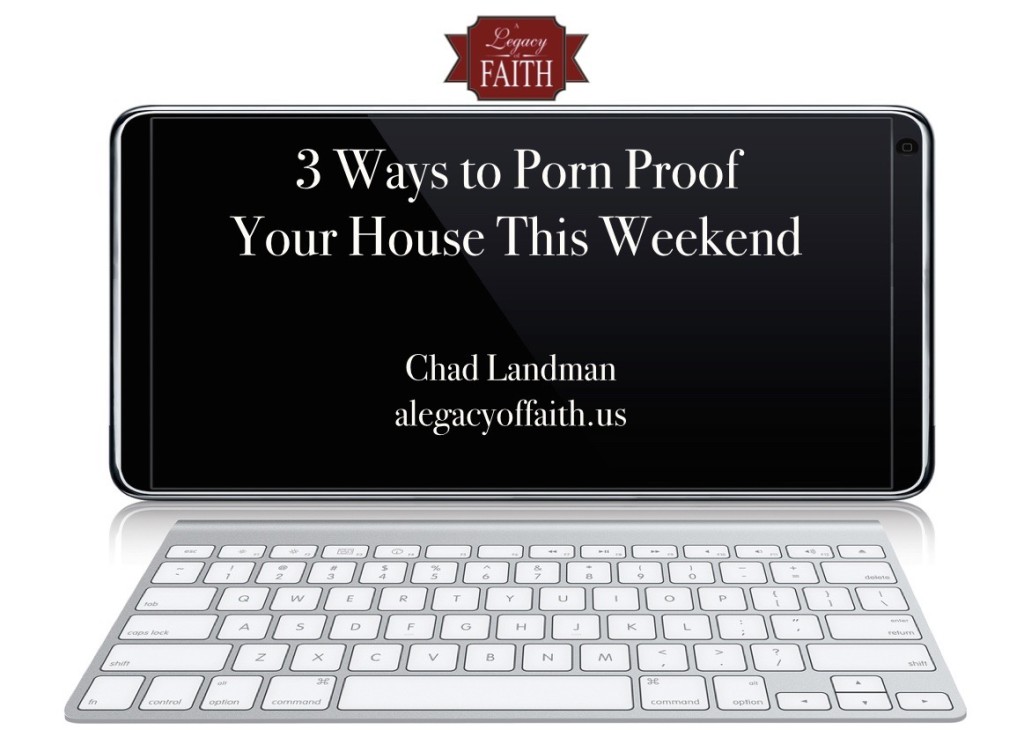3 Ways to Porn Proof Your House This Weekend
[Editors Note: This week’s guest post is from Chad Landman. Find out more about Chad, and many of his good works, at the end of today’s article.]
According to the Huffington Post, porn sites get more visitors each month than Netflix, Amazon and Twitter…*combined.* While numbers have been misleading saying exactly how much of the internet is pornography (numbers fluctuate erratically based upon different sources between 18 and 80 percent), the traffic to these sites can be measured with some accuracy, and most sources say that it’s around 30% of all internet traffic that visits porn sites. People are visiting these sites – of that there is no doubt.
Every 1 in 5 searches made on a mobile device are for porn. The average age of the first internet exposure to pornography has dropped dramatically in the last 15 years, from 14 in 2000, 11 in 2009, to just 8 years old in 2014.
Does that scare you? It should.
According to Richard L. Bready of Saint Anselem College, “Porn use is a greater threat to our national well-being than our economy.”
So what are you doing about it?
Today I’d like to present you with three ways to porn-proof your home this weekend.
1) Make a list of all devices that connect to the internet. Think about all of them. Your son’s iPod Touch, your daughter’s Kindle Fire, your own mobile phones and your laptop in the living room. Are you even aware of what devices are in your own home? Most aren’t. The first step in porn-proofing is to identify what devices access the internet in your home, and then you’ll have a better idea of how to attack this problem. Get out a legal pad and make two columns: “Device” and “Security.” The device could be anything – your DVR, your Smart TV, a tablet, even your refrigerator these days. For Security, write down whatever passwords access the device, and note what parental controls you have set on those devices. I can’t speak for most other devices, but iOS has some pretty comprehensive parental controls built right in to the operating system, as does Windows. You can check out my How-To guides for iOS and PC’s here.
2) Keep all devices in a public place and set limits. Ten years ago, this wasn’t as difficult because you had one desktop or laptop computer – there were hardly any tablets or smartphones to speak of. One of the things that parents always tell me when I go to congregations to speak about internet safety is that they wish they would have not allowed devices in their kids’ bedrooms. Before it was televisions, now it’s tablets and smartphones. It won’t be a popular decision with your family, but if you can keep them in eyesight while they’re home and set parental controls and time limits while you’re not home, it will go a long way to porn-proofing your home.
If you have a PC laptop or desktop at home, Microsoft has some excellent built-in parental controls to set timers on what your child or even your spouse can use. For iOS devices, I recommend the excellent app called Curbi. Curbi lets you set time limits and parental controls on your device when it’s connected with your child’s device. It has a small fee per month, but ask this question: would you pay the price of a latte to help protect your family in the digital space?
3) Talk to your family. This sounds simple to say, but it’s also hard to do. How many times have you talked to your kids this month about sex, drugs, or alcohol? If you’re a good parent, these subjects come up regularly. How about the internet? When was the last time you checked the browsing history on your daughter’s tablet? Or the Youtube videos your son has been watching on his iPhone? Studies have shown that kids that know if their parents are watching and actively talking to them about their internet use (and this goes for spouses too) are much less likely to seek out the bad things on the internet and are more cautious where they tread. Make sure your family knows where you stand. Have them sign a Parent-Child Device Contract. Explain to them the consequences of their behavior online. But most importantly, keep it in the conversation as much as you can.
These are three very simple and basic ideas to porn-proof your home, and these are just the start. Porn-proofing your home and keeping your family safe online is a full-time job. My prayer today is for you to have the faith maintain vigilance in the seemingly insurmountable task of keeping your family safe online.
We must always remember that we must build every facet of our homes with God in mind, and this includes internet safety. Psalm 127.1 – Unless the LORD builds the house, those who build it labor in vain.
——-
Chad Landman is the Education Minister at the Graymere Church of Christ in Columbia, Tennessee. He writes on his personal blog at chadl.co, on the Active Digital Parenting blog on Start2Finish, and talks about technology in ministry on his podcast Ministry Bits.
(Photo background credit: Chris Messina on Creative Commons)



